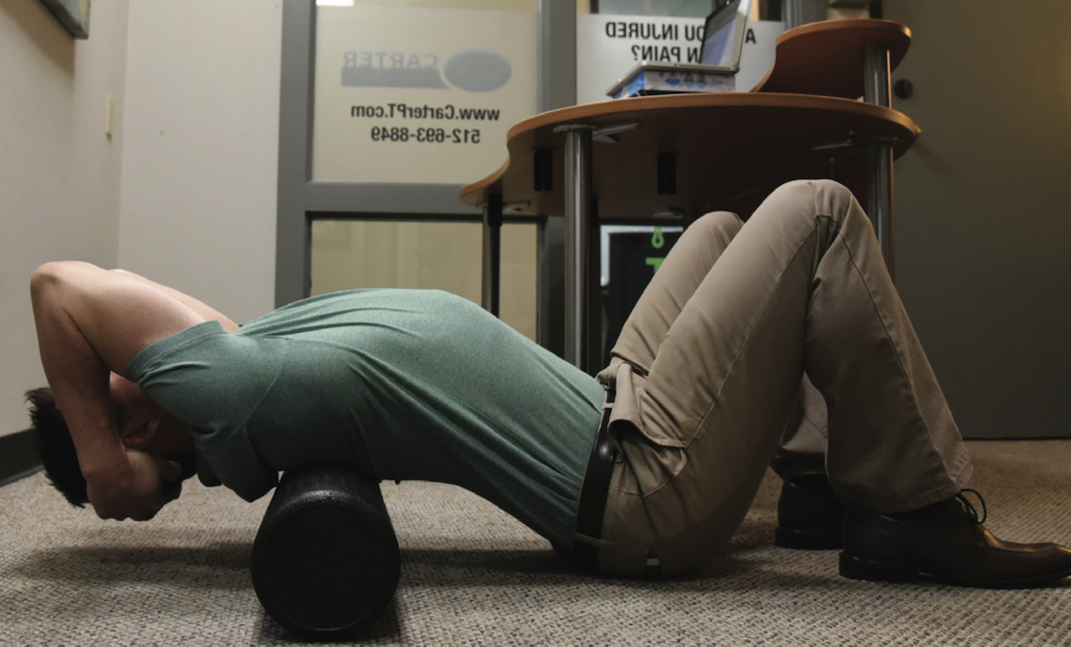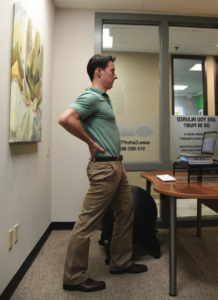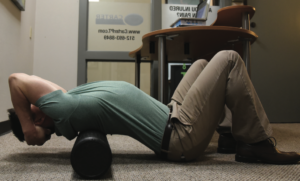Stretch Away the Stiffness of Prolonged Sitting

As the world tries to move back to normalcy, many people are planning much-needed trips and vacations and, as physical therapists say, “it’s all fun and games till someone’s back goes out.”
Just kidding, I’m the only physical therapist I know who says that.
Dad/PT jokes aside, the main component of long flights and/or road trips is prolonged sitting, which most commonly leads to pain or other problems. While most people think lumbar spine compression (which is more pronounced in sitting than standing) is the primary cause of this issue, a lesser-known factor involves the hip flexors.
Let me explain.
In the seated position, our hips are flexed, which puts our hip flexor muscles in a shortened position. Biological tissue tends to adapt over time to the positions and forces that we put through it. So, if we hold a muscle in a shortened position long enough, over time the muscle will become more permanently shortened and “tight.” In other words, prolonged sitting can have both temporary as well as more permanent effects on the length of our hip flexor muscles and the surrounding connective tissues.
Why is that an undesirable thing?
Well, the hip flexors attach to the spine and pelvic bones in a way that causes compression of the spine when they are tight or spasming. If the hip flexors become especially tight, it can limit our ability to gain a fully upright posture when we stand. When you see an elderly person bent forward as they stand or walk, tight hip flexors have a large role in what you’re seeing. If you have back pain that is worsened or “pinches” when you bend backward, it’s almost certain that your hip flexors are too tight or are currently in a state of spasm or “guarding.”
So, the moral of the story is that if you want to reverse one of the most common, negative effects of long flights and road trips, you need to stretch your hip flexors and move your spine into extension. Below are a few easy-to-use stretches on your trips this summer and beyond, but, before we dive into those stretches, I want to give some general travel tips to keep you moving and feeling good while on vacation:
- Choose your seat wisely: If you’re flying, get an aisle seat so you can easily stand up as often as needed.
- Low-back support: Unfortunately, most seats in airplanes are designed without much/any lumbar support, allowing you to slouch if you’re not actively holding your low back straight (which is unreasonable to attempt for hours at a time and impossible if you’re asleep). I use this inflatable lumbar support that’s small and easy to pack away. I use it when driving in my old Land Cruiser as well.
- Foot pumps: Get your feet pumping up and down every once in a while to keep blood flowing and combat stiffness and swelling with long flights or drives.
- Butt squeezes: Sounds funny but this, too, will combat stiffness, get the blood flowing and burn a few extra calories while sitting.
- Hydrate: Our bodies dehydrate more quickly up in the sky. Whether you’re flying or driving, don’t forget your water! You’ll enjoy your destination more if you’re feeling hydrated.
- Beware of hidden tension: If you’re driving, set an alarm reminder to relax shoulders down. A lot of people slightly elevate their shoulders when driving, especially in traffic, and that can lead to a lot of soreness on long trips.
Okay, back to our stretches…
When someone mentions hip flexor stretching, many people immediately think of the classic stretch where you’re kneeling on one knee and driving the hips forward. Unless you’re using it as part of a pre-workout warmup, I’m not a huge fan of this stretch for those seeking to create a true, long-term lengthening of the hip flexors (and not just a temporary stretch). The problem with this lunge-style position approach is that the hip flexors are contracting while you’re trying to lengthen them. If they are fully relaxed, you’d go into the splits and hurt yourself. Stretches in which the muscle you’re stretching is in a state of contraction can be great for warmups, but they don’t result in a long-term lengthening of the tight tissues.
Although the stretches below are both in a standing position (for ease of use while traveling), they can be done in a way that gives sufficient relaxation of the muscles to really get a good stretch.
Please note: Keep these gentle! Gentle stretches held for longer periods tend to be more effective at resolving tightness than brief, intense stretches.
Standing Hip Flexor Stretch

This stretch is a great way to quickly open up the hips and stretch your hip flexors without having to take a knee. The key here is to lock your back knee completely straight and then tuck your hips under, rolling your pelvis posteriorly like you’re trying to flatten your low back. If done correctly, you’ll feel a stretch somewhere around the front side of your hip. There shouldn’t be any pain or discomfort with this stretch. If there is, consult your physical therapist. Hold a gentle stretch for at least 60 seconds.
Lumbar Backward Bends
Back extension is a highly important range of motion that many people lose over time with age and desk jobs. Here is the key to limiting compression of the spine and making this a beneficial and comfortable stretch: You should be letting your hips glide forward, not leaning your shoulders backward. If you keep your eyes on the horizon with your shoulders staying over your feet (not shifting backward behind your feet), your abdominals can relax and this will provide a nice extension of the lumbar spine and stretch of the hip flexors. Do 10-20 gentle repetitions every few hours in flight or on pit stops.

I chose these two stretches because you don’t need to kneel or lay down to do them, so they’re easy to use even in a busy airport or gas station. However, when you make it to a bed in the evening, here’s another hip flexor stretch that my patients with sitting-induced-back-stiffness tend to really love.
If you travel with a foam roller, try this nice back arch stretch at the end of a long day on the road or in the sky.

So, there you have it! Two highly effective but easy-to-use stretches to reverse the effects of long flights and drives. If you have any questions or any pain that might keep you from enjoying your upcoming vacations to the fullest, let us know or find a great physical therapist in your neck of the woods.
About the Author

Jarod Carter PT, DPT, MTC is the founder of Carter Physiotherapy, where active people in Austin go to quickly recover from injury so they can keep playing their sport, exercising, and enjoying life. Offering specialized hands-on manual therapy as well as online telehealth treatment options, all sessions are one-on-one with a Doctor of Physical Therapy and designed to get you maximal results as quickly as possible. Jarod is also the author of two books and has helped thousands of healthcare providers around the world to create private practices offering the highest level of treatment and care. Jarod provides monthly resources and discounts specifically for Austin Fit Magazine readers here: www.CarterPT.com/AFM






